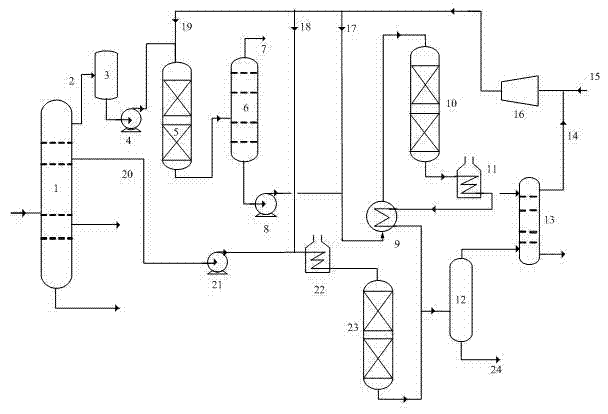Low energy consumption catalytic gasoline hydrodesulfurization method
A catalytic gasoline and hydrodesulfurization technology, which is applied in the fields of hydrotreating process, petroleum industry, and hydrocarbon oil treatment, can solve the problems of large octane number loss and poor adaptability of feedstock oil, etc., and reduce energy consumption and equipment investment And operating costs, technical solutions mature and reliable effect
- Summary
- Abstract
- Description
- Claims
- Application Information
AI Technical Summary
Problems solved by technology
Method used
Image
Examples
Embodiment 1
[0040] The gasoline raw material 1 is pre-separated in the fractionation tower of the catalytic cracking unit to obtain light fractions and heavy fractions. The separation temperature of the light fractions and heavy fractions is 125°C; the light fractions undergo hydromercaptan conversion and then enter hydrogenation pre-fractionation The tower is separated, and the cut-off temperature of the obtained light gasoline and medium gasoline is 65°C. Among them, the conversion reaction conditions of hydrogen mercaptans are: hydrogen partial pressure 2.0 MPa, volume space velocity 4.8 h -1 , The reaction temperature is 148°C, the volume ratio of hydrogen to oil is 12; the reaction conditions of hydrodesulfurization of distillate in catalytic gasoline are: hydrogen partial pressure 1.6MPa, volume space velocity 3.0h -1 , The reaction temperature is 248°C, the total hydrogen-to-oil volume ratio is 350; the catalytic gasoline heavy fraction hydrodesulfurization reaction conditions are:...
Embodiment 2
[0044] The gasoline raw material is pre-separated in the fractionation tower of the catalytic cracking unit to obtain light fractions and heavy fractions; the division temperature of the light fractions and heavy fractions is 120°C; the light fractions undergo hydromercaptan conversion and then enter the hydrogenation pre-fractionation tower Separation is carried out, and the cut-off temperature of gained light gasoline and medium gasoline is 70 ℃. The reaction conditions for the conversion of hydrogen mercaptans are: hydrogen partial pressure 2.2 MPa, volume space velocity 5.4 h -1 , the reaction temperature is 157°C, the volume ratio of hydrogen to oil is 18; the reaction conditions of hydrodesulfurization of distillate in catalytic gasoline are: hydrogen partial pressure 1.8MPa, volume space velocity 3.2 h -1 , The reaction temperature is 246°C; the total hydrogen-to-oil volume ratio is 380; the catalytic gasoline heavy fraction hydrodesulfurization reaction conditions are:...
Embodiment 3
[0048] The gasoline raw material 3 is pre-separated in the fractionation tower of the catalytic cracking unit to obtain light fractions and heavy fractions; the division temperature of the light fractions and heavy fractions is 130°C; the light fractions undergo hydrogen mercaptan conversion, and then enter the catalytic gasoline fraction Separation is carried out in the hydrogenation pre-fractionation tower, and the division temperature of the obtained light gasoline and medium gasoline is 68°C. Among them, the conversion reaction conditions of hydrogen mercaptans are: hydrogen partial pressure 1.8 MPa, volume space velocity 4.5 h -1 , the reaction temperature is 152°C, and the volume ratio of hydrogen to oil is 12; the reaction conditions for hydrodesulfurization of fractions in catalytic gasoline are: hydrogen partial pressure 1.6MPa, volume space velocity 3.2 h -1 , The reaction temperature is 252°C; the total hydrogen to oil volume ratio is 320; the catalytic gasoline hea...
PUM
 Login to View More
Login to View More Abstract
Description
Claims
Application Information
 Login to View More
Login to View More - R&D
- Intellectual Property
- Life Sciences
- Materials
- Tech Scout
- Unparalleled Data Quality
- Higher Quality Content
- 60% Fewer Hallucinations
Browse by: Latest US Patents, China's latest patents, Technical Efficacy Thesaurus, Application Domain, Technology Topic, Popular Technical Reports.
© 2025 PatSnap. All rights reserved.Legal|Privacy policy|Modern Slavery Act Transparency Statement|Sitemap|About US| Contact US: help@patsnap.com

